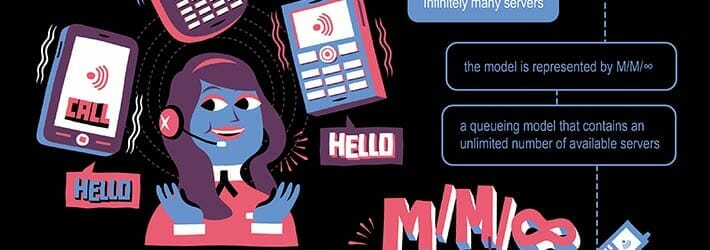- Log In
- Support
- Company
- Contact Us
- Live answers @ 1-888-532-4794
Infographic explaining queueing theory.

Do you like waiting in line? If you said yes, then we seriously question your judgment. The fact is that no one we know likes waiting in line. Whether you’re loitering around the Haunted Mansion ride at Disney, or camping outside of Best Buy at 3 a.m. on Black Friday hoping to score a 60-inch flat screen TV for 10 bucks, waiting in line is seriously annoying. Waiting on hold is equally annoying. Queueing Theory is not.
ueueing theory can be described as the mathematical study of waiting in lines, or queues. It originated with Danish engineer, Agner Krarup Erlang when he created models to define the Copenhagen telephone exchange. Since that time, queueing theory has been applied to such areas as the telecom industry, traffic engineering, computers, and architectural design.
Queueing is comprised of single or multiple server queues. It’s often used in call centers to assist with performance management, agent scheduling, and overall call efficiency to ensure customer satisfaction. Then there’s all of this other technical stuff like Erlang models, Kendall’s notation, and a slew of other mechanics that there is just no need for us to go into here. That’s why we created the infographic that you’re about to peruse.

Copy the code below to use this infographic:
[html]
<img title=”Call Center Queueing Theory Infographic” alt=”Call Center Queueing Theory Infographic” src=”https://www.specialtyansweringservice.net/wp-content/uploads/infographic-explaining-queueing-theory/queueing-theory-infographic.jpg” width=”710″ />
<pre><em>Image originally posted on <a href=”https://www.specialtyansweringservice.net/infographic-explaining-queueing-theory/”>The SAS Blog</a></em>
[/html]
Categories
- Advice (32)
- Answering Service 101 (18)
- Best Practices (10)
- Call Center Jobs (6)
- Call Center Software (20)
- Comparison (2)
- Customer Service (30)
- Funny (31)
- Holidays (19)
- Industry Hacks (19)
- Infographics (53)
- International (1)
- Medical (8)
- News (12)
- Phone Etiquette (2)
- Phones (14)
- Pricing (8)
- Quizzes (3)
- Receptionist (11)
- SAS Products (29)
- Scripting (4)
- Services (5)
- Small Business (25)
- Starting Up (7)
- Tips and Tricks (19)
- Uncategorized (1)
- Videos (19)
- Workplace (6)
Recently writen
- Call Center Script Best Practices: Advanced Script Block Tips to Optimize Your Answering Service
- January 2025 Release Notes – Adjustments to Call Details Timeline, New Scripting Updates, Live Transcription, and more!
- April 2024 Release Notes – Voicemail Greetings, Ability to Access Websites With a Username and Password, and more!
- March 2024 Release Notes – New Add-On, Settings Revamp, and more!
Follow Us
How about a demo?
We'll show you how our web portal works and answer any questions you have about SAS.
Schedule a demo







